Disaggregation Method of Carbon Emission: A Case Study in Wuhan, China
Abstract
1. Introduction
2. Research Area and Data
2.1. Research Area
2.2. Data Sources
2.2.1. Carbon Emission Inventory
2.2.2. Census of Geographical Conditions Data
3. Research Methods and Models
3.1. Total Carbon Emissions Estimation
3.2. Dissageration Method of Carbon Emissions
3.2.1. Single Scale Factor Model
3.2.2. Multi Scale Factors Model
3.2.3. Geographical Weighted Statistics Model
4. Results and Discussions
4.1. Carbon Emission Characteristics in Wuhan
4.2. Carbon Emission Characteristics of Different Regions
4.3. Carbon Emission Characteristics in Different Sectors
4.4. GW Spatial Correlation Analysis
4.5. Comparisons with Other Studies
5. Conclusions
Author Contributions
Funding
Acknowledgments
Conflicts of Interest
References
- OECD. Cities and Climate Change; OECD Publishing: Paris, France, 2010. [Google Scholar]
- IEA. Cities, Towns & Renewable Energy; IEA: Paris, France, 2009. [Google Scholar]
- UN-HABITAT. State of the World’s Cities 2010/2011: Bridging the Urban Divide; UN-HABITAT: Nairobi, Kenya, 2010. [Google Scholar]
- O’Neill, B.C.; Dalton, M.; Fuchs, R.; Jiang, L.; Pachauri, S.; Zigova, K. Global demographic trends and future carbon emissions. Proc. Natl. Acad. Sci. USA 2010, 107, 17521–17526. [Google Scholar] [CrossRef]
- Sovacool, B.K.; Brown, M.A. Twelve metropolitan carbon footprints: A preliminary comparative global assessment. Energy Policy 2009, 38, 4856–4869. [Google Scholar] [CrossRef]
- IPCC. 1996 IPCC Guidelines for National Greenhouse Gas Inventories [EB/OL]. (1996-05-20). Available online: http://www.ipcc=nggip.iges.or.jp/public/gl/invsl.html (accessed on 2 November 2018).
- IPCC. 2006 IPCC Guidelines for National Greenhouse Gas Inventories [EB/OL]; (2006-05-20); IPCC: Geneva, Switzerland, 2006. [Google Scholar]
- Bofeng, C.; Chunlan, L.; Caocao, C. Urban Greenhouse Gas Inventory Study; Chemical Industry Press: Beijing, China, 2009. [Google Scholar]
- Bofeng, C. Low-Carbon Urban Planning; Chemical Industry Press: Beijing, China, 2011. [Google Scholar]
- World Resources Institute; Institute for Urban and Environmental Studies Chinese Academy of Social Science; World Wide Fund for Nature. Guidelines for Urban Greenhouse Gas Accounting Tools (Beta 1.0); World Resources Institute, Chinese Academy of Social Science China: Beijing, China, 2013. [Google Scholar]
- Bofeng, C. Advance and Review of City Carbon Dioxide Emission Inventory Research. China Popul. Resour. Environ. 2013, 23, 72–80. [Google Scholar]
- Kennedy, C.; Steinberger, J.; Gasson, B.; Hansen, Y.; Hillman, T.; Havránek, M.; Pataki, D.; Phdungsilp, A.; Ramaswami, A.; Mendez, G.V. Greenhouse gas emissions from global cities. Environ. Sci. Technol. 2009, 43, 7297–7302. [Google Scholar] [CrossRef] [PubMed]
- Newton, P.; Marchant, D.; Mitchell, J.; Plume, J.; Seo, S.; Roggema, R. Performance Assessment of Urban Precinct Design: A Scoping Study; CRC for Low Carbon Living: Sydney, Australia, 2013. [Google Scholar]
- Trubka, R.; Glackin, S.; Lade, O.; Pettit, C. A web-based 3D visualisation and assessment system for urban precinct scenario modelling. ISPRS J. Photogramm. 2016, 117, 175–186. [Google Scholar] [CrossRef]
- Andrews Cliton, J. Greenhouse gas emissions along the rural-urban gradient. J. Environ. Plan. Manag. 2008, 51, 847–870. [Google Scholar] [CrossRef]
- Ewing, R.; Rong, F. The impact of urban from on US residential energy use. Hous. Policy Debate 2008, 19, 1–30. [Google Scholar] [CrossRef]
- Olivier, J.G.; Van Aardenne, J.A.; Dentener, F.J.; Pagliari, V.; Ganzeveld, L.N.; Peters, J.A. Recent trends in global greenhouse gas emissions: Regional trends 1970–2000 and spatial distribution of key sources in 2000. Environ. Sci. 2005, 2, 81–99. [Google Scholar] [CrossRef]
- Meng, L.; Graus, W.; Worrell, E.; Huang, B. Estimating CO2 (carbon dioxide) emissions at urban scales by DMSP/OLS (Defense Meteorological Satellite Program’s Operational Linescan System) nighttime light imagery: Methodological challenges and a case study for China. Energy 2014, 71, 468–478. [Google Scholar] [CrossRef]
- Gurney, K.R.; Razlivanov, I.; Song, Y.; Zhou, Y.; Benes, B.; Abdul-Massih, M. Quantification of fossil fuel CO2 emissions on the building/street scale for a large US City. Environ. Sci. Technol. 2012, 46, 12194–12202. [Google Scholar] [CrossRef]
- Wang, H.; Zhang, R.; Liu, M.; Bi, J. The carbon emissions of Chinese cities. Atmos. Chem. Phys. 2012, 12, 6197–6206. [Google Scholar] [CrossRef]
- Olivier, J.G.; Janssens-Maenhout, G.; Peters, J.A. Trends in Global CO2 Emissions: 2012 Report; PBL Netherlands Environmental Assessment Agency Hague: Den Haag, The Netherlands, 2012. [Google Scholar]
- Asefi-Najafabady, S.; Rayner, P.J.; Gurney, K.R.; McRobert, A.; Song, Y.; Coltin, K.; Huang, J.; Elvidge, C.; Baugh, K. A multiyear, global gridded fossil fuel CO2 emission data product: Evaluation and analysis of results. J. Geophys. Res. Atmos. 2014, 119, 10213–210231. [Google Scholar] [CrossRef]
- Rayner, P.J.; Raupach, M.R.; Paget, M.; Peylin, P.; Koffi, E. A new global gridded data set of CO2 emissions from fossil fuel combustion: Methodology and evaluation. J. Geophys. Res. Atmos. 2010, 115, D19. [Google Scholar] [CrossRef]
- Wang, J.; Cai, B.; Zhang, L.; Cao, D.; Liu, L.; Zhou, Y.; Zhang, Z.; Xue, W. High resolution carbon dioxide emission gridded data for China derived from point sources. Environ. Sci. Technol. 2014, 48, 7085–7093. [Google Scholar] [CrossRef]
- Huang, B.; Xing, K.; Pullen, S. Energy and carbon performance evaluation for buildings and urban precincts: Review and a new modelling concept. J. Clean. Prod. 2015, 1–12. [Google Scholar] [CrossRef]
- Oda, T.; Maksyutov, S. A very high-resolution global fossil fuel CO2 emission inventory derived using a point source database and satellite observations of night lights, 1980–2007. Atmos. Chem. Phys. Discuss. 2010, 10, 16307–16344. [Google Scholar] [CrossRef]
- Zhao, Y.; Nielsen, C.P.; McElroy, M. China’s CO2 emissions estimated from the bottom up: Recent trends, spatial distributions and quantification of uncertainties. Atmos. Environ. 2012, 59, 214–223. [Google Scholar] [CrossRef]
- Andres, R.J.; Marland, G.; Fung, I.; Matthews, E. A 1° × 1° distribution of carbon dioxide emissions from fossil fuel consumption and cement manufacture, 1950–1990. Glob. Biogeochem. Cycles 1996, 10, 419–429. [Google Scholar] [CrossRef]
- Wang, J.N.; Cai, B.F.; Cao, D. China 10 km carbon dioxide emissions grid dataset and spatial characteristic analysis. China Environ. Sci. 2014, 34, 2220–2227. [Google Scholar]
- Wuhan Land Resources and Planning Bureau, Wuhan Geomatics Institute. 2016 Wuhan Geographic Information Blue Book; Wuhan Geomatics Institute: Wuhan, China, 2016. [Google Scholar]
- Yang, X.; Cai, Y.; Zhang, A. Spatial-temporal characteristics and affecting factors decomposition of carbon emission in Wuhan urban circle from 2001 to 2009. Resour. Environ. Yangtze Basin 2013, 22, 1389–1396. [Google Scholar]
- Wuhan Land Resources and Planning Bureau, Wuhan Traffic Development Strategy Research Institute. 2016 Wuhan Traffic Development Annual Report; Wuhan Traffic Development Strategy Research Institute: Wuhan, China, 2016. [Google Scholar]
- Brunsdon, C.; Fotheringham, A.S.; Charlton, M. Geographically weighted summary statistics—A framework for localised exploratory data analysis. Comput. Environ. Urban Syst. 2002, 26, 501–524. [Google Scholar] [CrossRef]
- Gollini, I.; Lu, B.; Charlton, M.; Brunsdon, C.; Harris, P. GWmodel: An R package for exploring spatial heterogeneity using geographically weighted models. J. Stat. Softw. 2015, 63, 1–50. [Google Scholar] [CrossRef]
- Lu, B.; Harris, P.; Charltion, M.; Brunsdon, C. The gwmodel r package: Further topics for exploring spatial heterogeneity using geographically weighted models. Geo-Spat. Inf. Sci. 2014, 17, 85–101. [Google Scholar] [CrossRef]
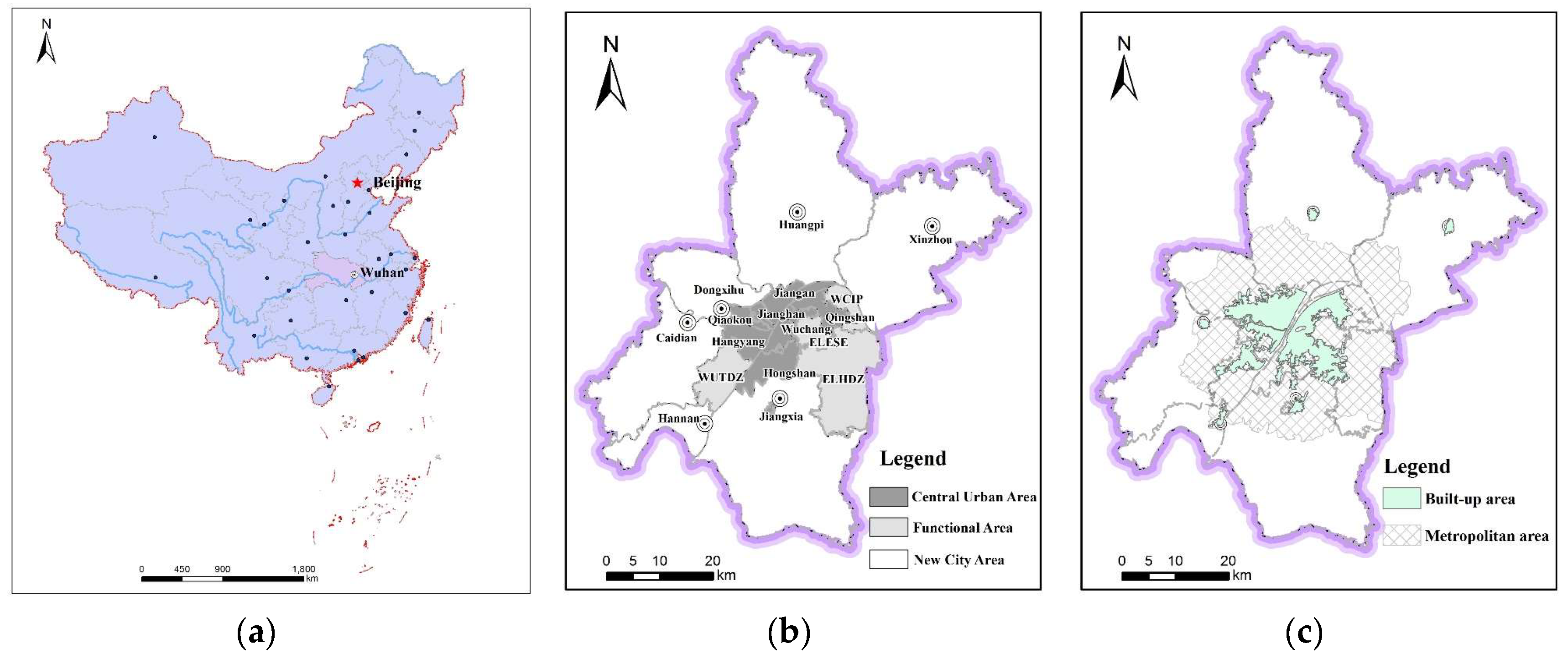
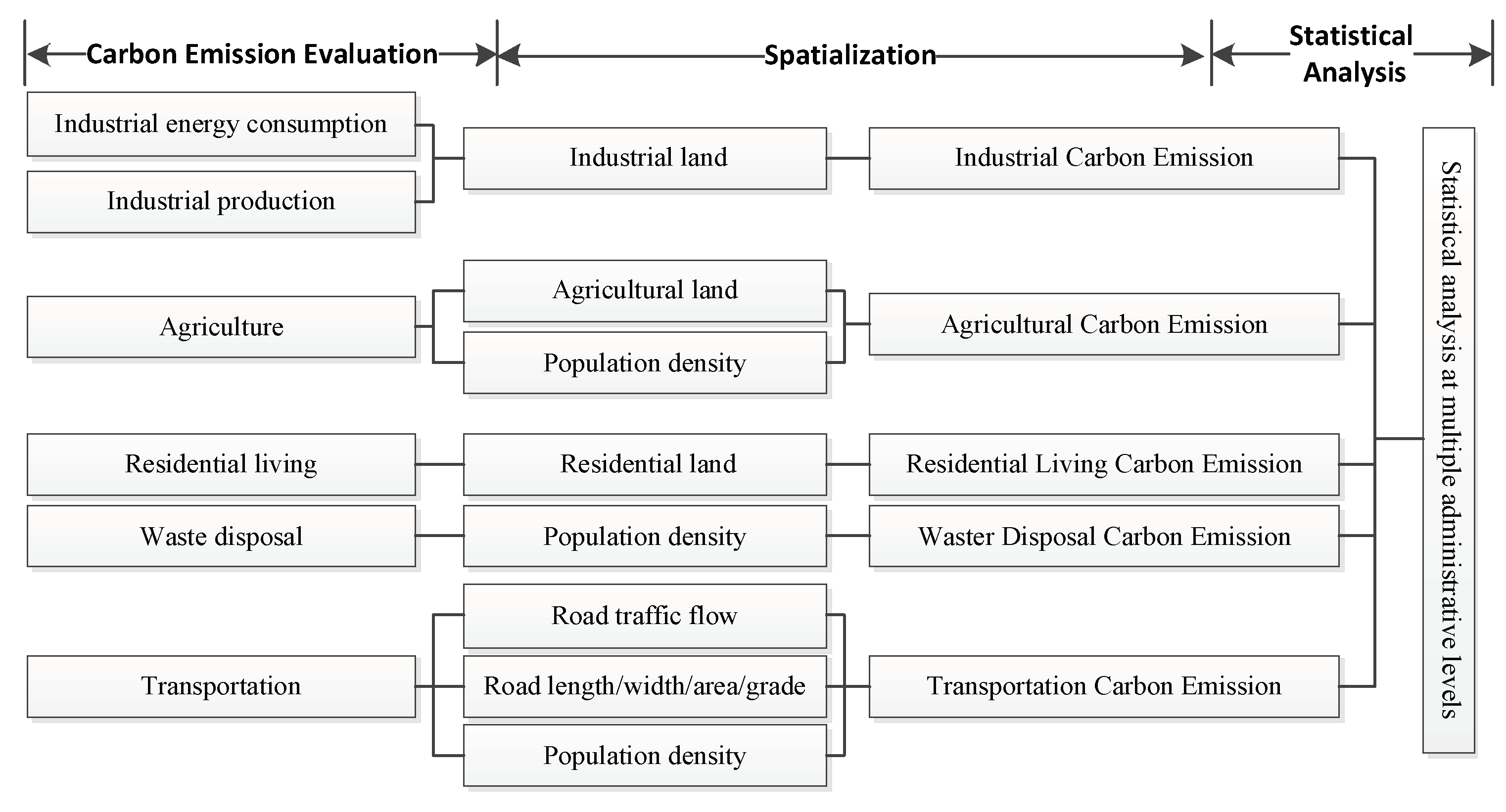
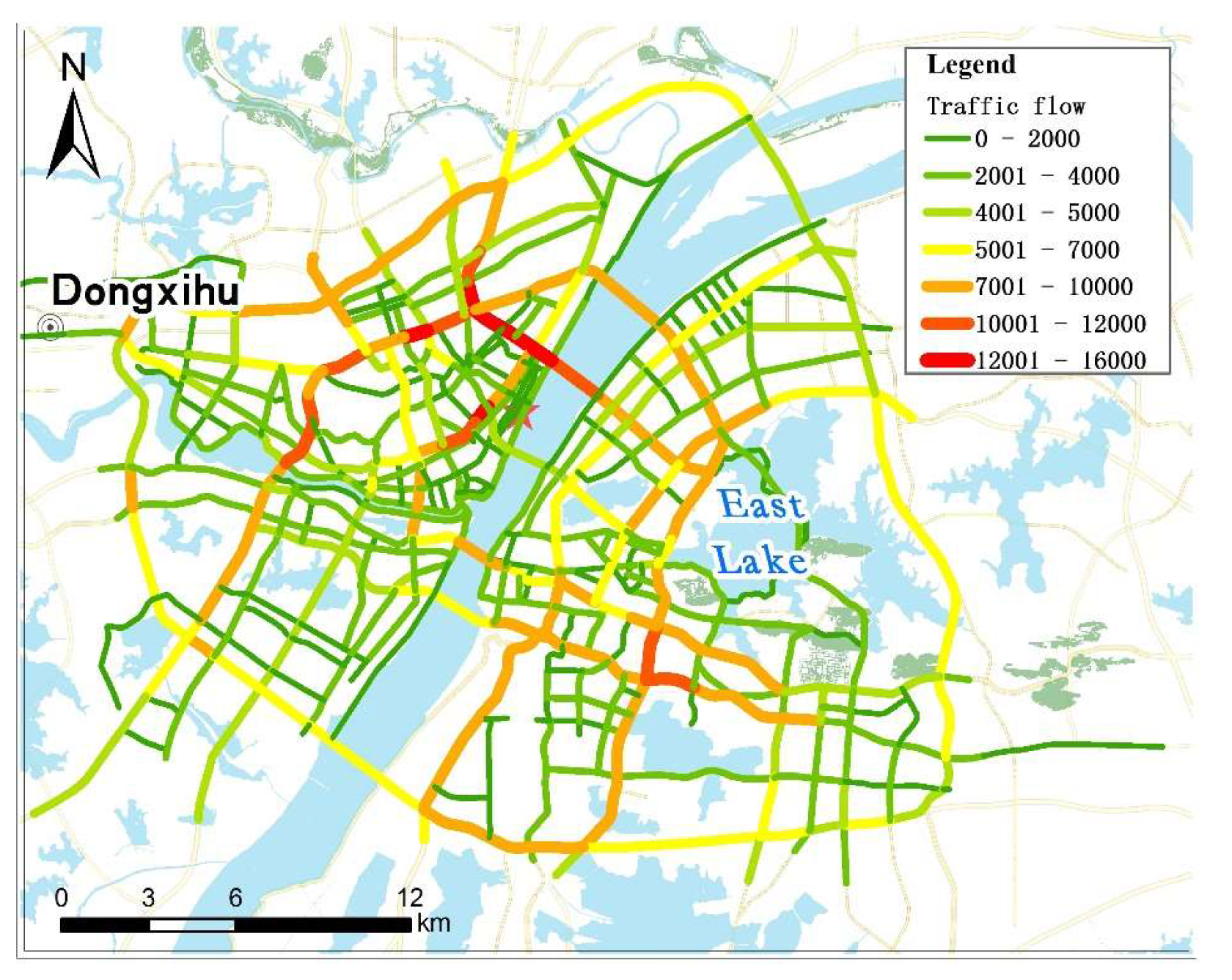
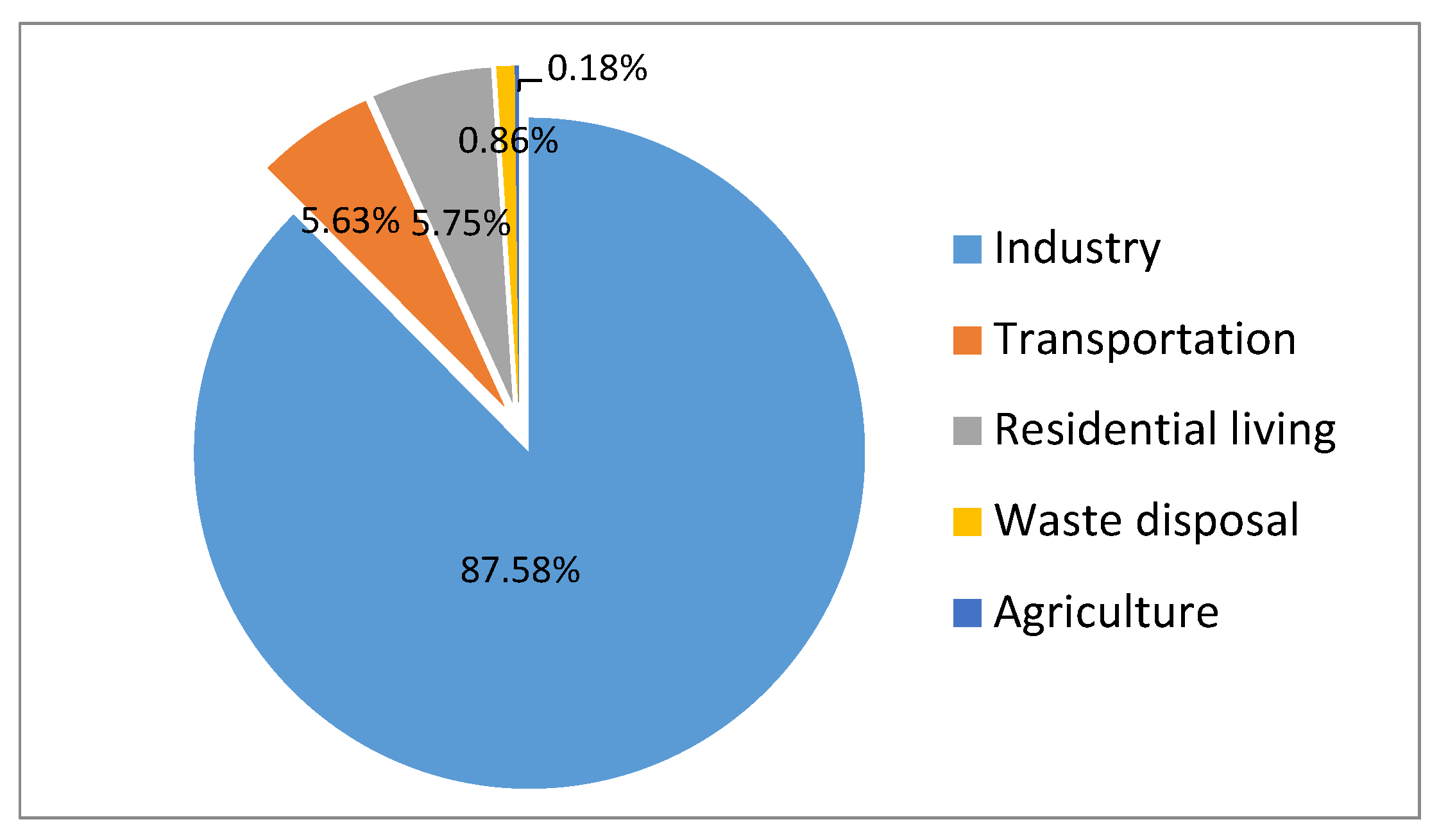
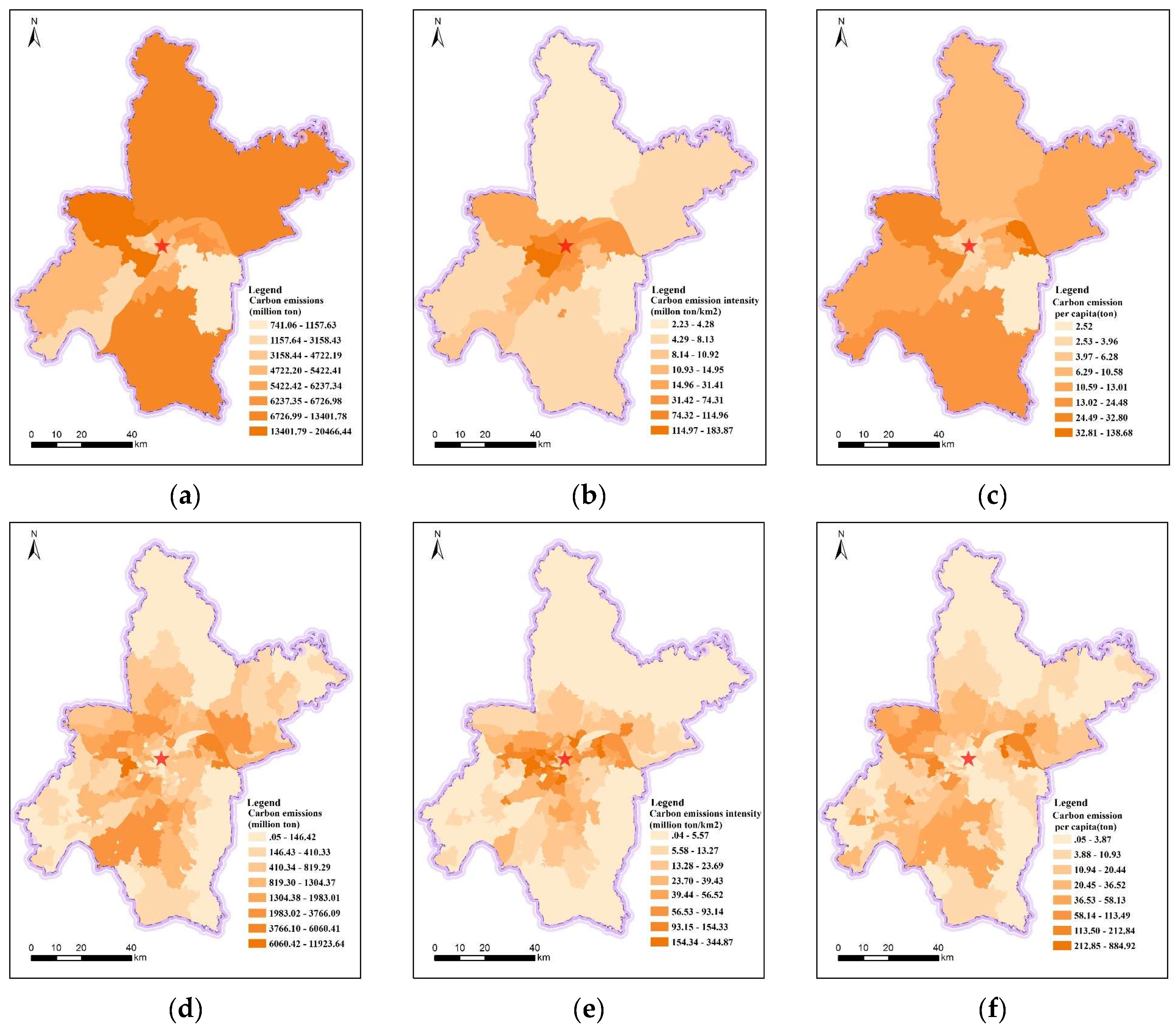
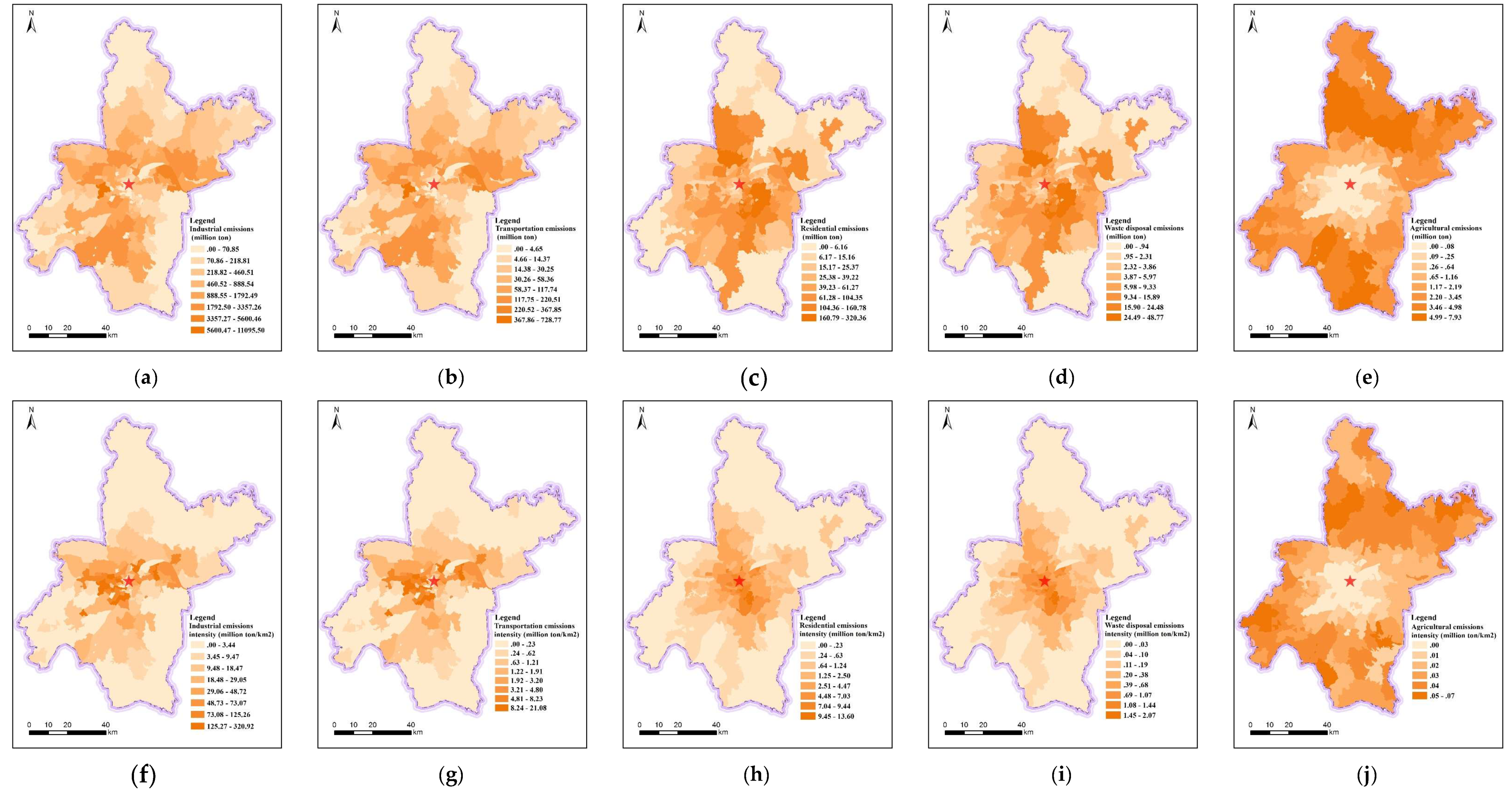
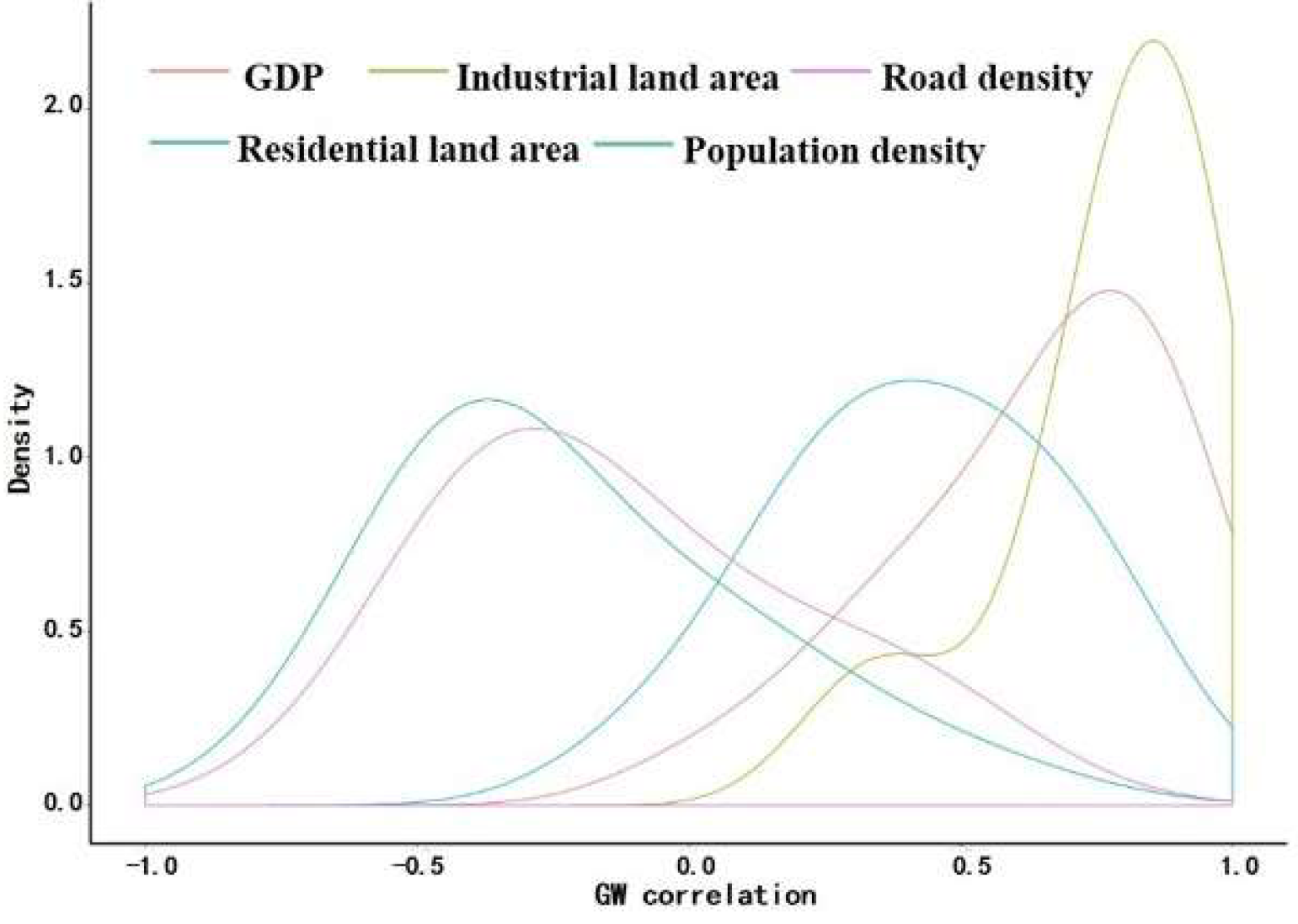
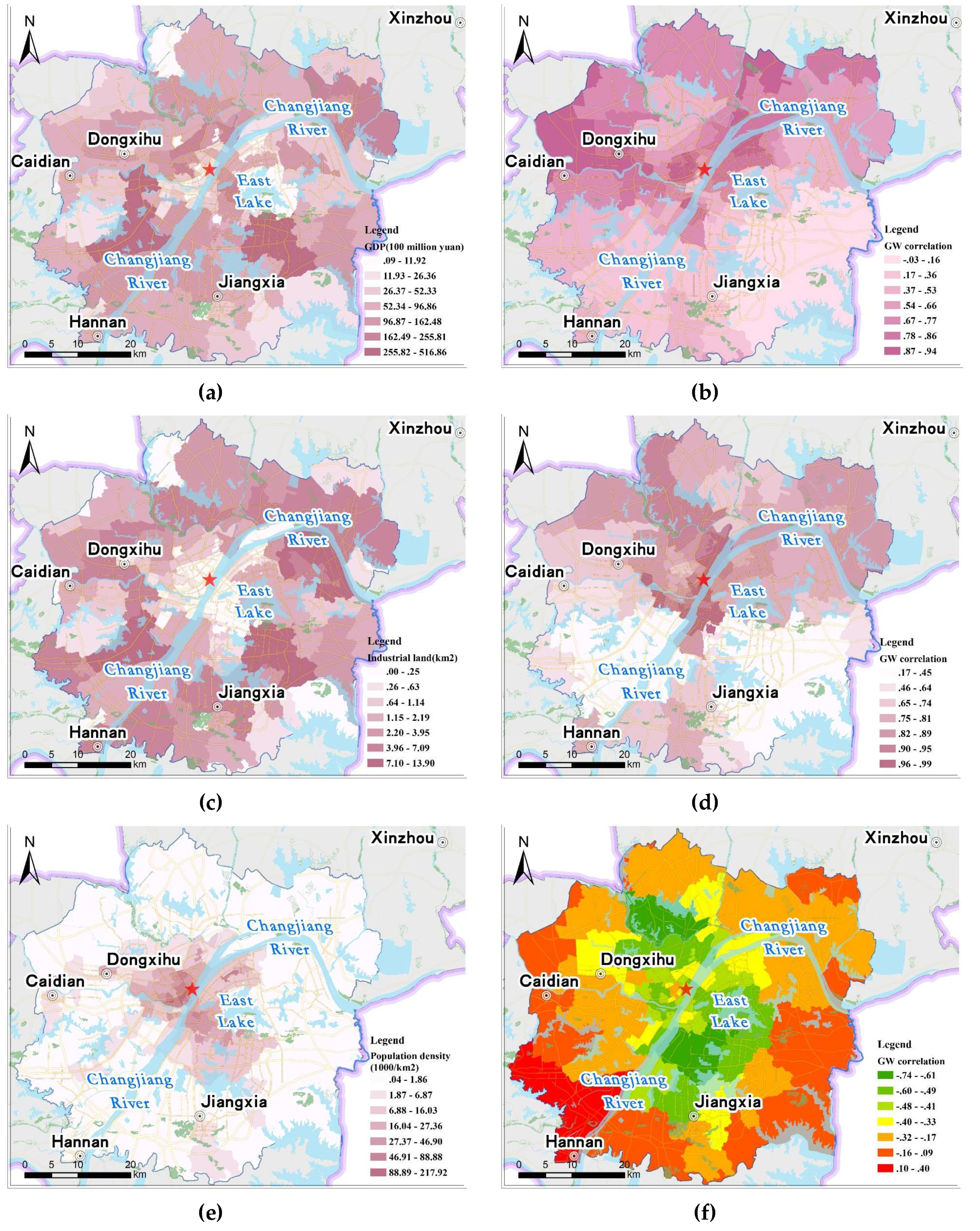
| Sector | Category | Carbon Emission Factors | Reference Source |
|---|---|---|---|
| Energy consumption | Coal | 0.7559 t/t | T.O. West, American Oak Ridge National Laboratory |
| Coke | 0.855 t/t | American Oak Ridge National Laboratory | |
| Crude oil | 0.5857 t/t | IREEA | |
| Aviation gasoline | 0.6185 t/t | IPCC | |
| Motor gasoline | 0.5538 t/t | China Agricultural University School of Biology | |
| Diesel oil | 0.5927 t/t | Dubey | |
| Kerosene | 0.5714 t/t | IPCC | |
| Refinery gas | 0.4602 t/t | IPCC | |
| Liquefied petroleum Gases | 0.5042 t/t | IPCC | |
| Coke oven gas | 0.3548 t/t | IPCC | |
| Electricity | Converted standard coal | IPCC | |
| Industrial Production | Soda ash | 0.1380 t/t | T.O. West, American Oak Ridge National Laboratory |
| Crude iron | 0.1100 t/t | IREEA | |
| Crude steel | 0.1100 t/t | IPCC | |
| Rolled Steel | 0.1100 t/t | China Agricultural University School of Biology | |
| Cement | 0.4083 t/t | Dubey | |
| Flat glass | 0.2100 t/t | IPCC | |
| Agriculture | Chemical fertilizer | 0.89 kg/kg | T.O. West, American Oak Ridge National Laboratory |
| Pesticides | 4.93 kg/kg | American Oak Ridge National Laboratory | |
| Plastic sheeting | 5.18 kg/kg | IREEA | |
| Diesel oil | 0.59 kg/kg | IPCC | |
| Irrigation | 25.00 kg/Cha | Dubey | |
| Residential living | Electricity | Converted standard coal | IPCC |
| Natural gas | |||
| Waste disposal | Domestic waste treatment | 0.35 t/t | American Oak Ridge National Laboratory |
| Transportation | Bus | 106.42 kg/100 km | Ministry of Transport of the People’s Republic of China |
| Taxi | 22.26 kg/100 km | ||
| Private car | 19.59 kg/100 km | ||
| Motorcycle | 6.68 kg/100 km | ||
| Big truck | 106.42 kg/100 km | ||
| Van | 53.20 kg/100 km |
| Category | Feature | Attributes Used |
|---|---|---|
| Land coverage | Land coverage data | Type |
| Road networks | Centerline of highway | Type, length, width, road grade |
| Centerline of city road | ||
| Centerline of country road | ||
| Geographic units | District (county) boundaries | Location, area |
| Street (township) boundaries | ||
| Industrial enterprises | ||
| Residential areas | ||
| Thematic data | Survey of population | Population |
| Traffic flow | Annual traffic flow of main road | |
| Statistical data | Economic and social data | GDP, Gross industrial output value above designated size, irrigation, consumption of materials in agricultural production, vehicle holdings and driving distance |
| Central City | Functional Area | New Urban Area | Built-up Area | Metropolitan Development Area | |
|---|---|---|---|---|---|
| Area ratio | 7.49% | 10.39% | 82.12% | 6.77% | 38.18% |
| Population ratio | 57.51% | 8.25% | 34.24% | 71.70% | 77.61% |
| Population density | 9499.39 | 982.3 | 515.68 | 13096.63 | 2514.39 |
| Agricultural land ratio | 1.23% | 6.67% | 92.08% | 0.24% | 22.80% |
| Road length ratio | 10.98% | 11.87% | 77.15% | 16.57% | 49.47% |
| Road density | 3.28 | 2.56 | 2.1 | 5.47 | 2.89 |
| Residential land ratio | 55.28% | 14.24% | 30.49% | 76.48% | 94.75% |
| Industrial land ratio | 17.98% | 20.43% | 61.59% | 43.69% | 80.20% |
| Carbon emission ratio | 42.84% | 9.12% | 48.04% | 29.47% | 86.47% |
| Industrial carbon emission ratio | 43.00% | 8.46% | 48.54% | 28.93% | 86.39% |
| Agricultural carbon emission ratio | 1.05% | 6.30% | 92.65% | 1.20% | 23.16% |
| Residential living carbon emission ratio | 41.70% | 18.71% | 39.59% | 38.04% | 89.39% |
| Transportation carbon emission ratio | 43.00% | 8.46% | 48.54% | 28.93% | 86.39% |
| Waste disposal carbon emission ratio | 41.70% | 18.71% | 39.59% | 38.04% | 89.39% |
| Carbon emission per capita | 9.07 | 12.53 | 15.9 | 4.65 | 12.63 |
| Variables | Correlation Coefficient | Min | Max | Mean | Median |
|---|---|---|---|---|---|
| Population density | −0.225 | −0.745 | 0.647 | −0.213 | −0.307 |
| GDP | 0.543 | −0.033 | 0.941 | 0.637 | 0.718 |
| Road denstiy | −0.147 | −0.704 | 0.630 | −0.122 | −0.202 |
| Residential land area | 0.202 | −0.162 | 0.912 | 0.423 | 0.415 |
| Industrial land area | 0.607 | 0.174 | 0.988 | 0.766 | 0.810 |
© 2019 by the authors. Licensee MDPI, Basel, Switzerland. This article is an open access article distributed under the terms and conditions of the Creative Commons Attribution (CC BY) license (http://creativecommons.org/licenses/by/4.0/).
Share and Cite
Luo, M.; Qin, S.; Chang, H.; Zhang, A. Disaggregation Method of Carbon Emission: A Case Study in Wuhan, China. Sustainability 2019, 11, 2093. https://doi.org/10.3390/su11072093
Luo M, Qin S, Chang H, Zhang A. Disaggregation Method of Carbon Emission: A Case Study in Wuhan, China. Sustainability. 2019; 11(7):2093. https://doi.org/10.3390/su11072093
Chicago/Turabian StyleLuo, Minghai, Sixian Qin, Haoxue Chang, and Anqi Zhang. 2019. "Disaggregation Method of Carbon Emission: A Case Study in Wuhan, China" Sustainability 11, no. 7: 2093. https://doi.org/10.3390/su11072093
APA StyleLuo, M., Qin, S., Chang, H., & Zhang, A. (2019). Disaggregation Method of Carbon Emission: A Case Study in Wuhan, China. Sustainability, 11(7), 2093. https://doi.org/10.3390/su11072093






